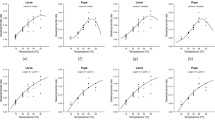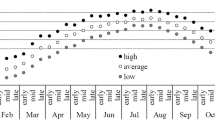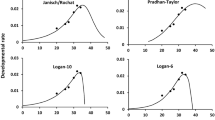Abstract
Riptortus pedestris (Fabricius) (Hemiptera: Alydidae) is an economically important insect pest of soybean. We investigated the developmental periods of each life stage as well as adult longevity and female fecundity. The study was conducted at eleven constant temperatures (12.0, 14.0, 15.9, 17.3, 19.3, 23.6, 28.3, 31.2, 34.2, 35.1, and 36.1 °C) for temperature-dependent development, and six constant temperatures (15.8, 19.7, 24.0, 27.8, 32.6, and 35.5 °C) for adult longevity and oviposition. Riptortus pedestris females showed successful egg-to-adult development from 17.9 to 36.1 °C, but failed to complete development under 15.9 °C. Using linear regression, lower developmental threshold (LDT) and thermal constant (K) for the total immature stage were estimated as 14.1 °C and 336.7°-day (DD), respectively. Higher and lower temperature threshold (TH and TL, respectively) were calculated using Lobry–Rosso–Flandrois (LRF) and Sharpe–Schoolfield–Ikemoto (SSI) models; a wider TL-to-TH temperature range (31.4 °C) was observed for LRF than for SSI (18.6 °C). The adult emergence frequency over the full range of constant temperatures was simulated using nonlinear developmental rate functions and the Weibull function. The daily egg production was predicted with respect to temperature and adult age. Biological characteristics of R. pedestris from different local populations are discussed.





Similar content being viewed by others
References
Bae S-D, Kim H-J, Park CG, Lee G-H, Park S-T (2005) The development and oviposition of bean bug, Riptortus clavatus Thunberg (Hemiptera: Alydidae) at temperature conditions. Korean J Appl Entomol 44:325–330 (in Korean with English summary)
Bae SD, Kim HJ, Yoon YN, Park ST, Choi BR, Jung JK (2009) Effect of a mungbean cultivar, jangannogdu on nymphal development, adult longevity and oviposition of soybean stink bugs. Korean J Appl Entomol 48:311–318 (in Korean with English summary)
Baek S, Hwang A, Kim H, Lee H, Lee J-H (2017) Temperature-dependent development and oviposition models of Halyomorpha halys (Hemiptera: Pentatomidae). J Asia-Pacific Entomol 20:367–375
Barnes AI, Wigby S, Boone JM, Partridge L, Chapman T (2008) Feeding, fecundity and lifespan in female Drosophila melanogaster. Proc R Soc B 275:1675–1683
Birch LC (1948) The intrinsic rate of natural increase of an insect population. J Animal Ecol 17:15–26
Briere JF, Pracros P, LeRoux AY, Pierre JS (1999) A novel rate model of temperature-dependent development for arthropods. Environ Entomol 28:22–29
Campbell A, Frazer BD, Gilbert N, Gutierrez AP, Mackauer M (1974) Temperature requirements of some aphids and their parasites. J Appl Ecol 11:431–438
Chung BK, Kang SW, Kwon JH (1995) Damages, occurrence and control of hemipterous insects in non astringent persimmon orchards. J Agric Sci 37:376–382 (in Korean with English summary)
Dixon AFG, Honĕk A, Kell P, Kotela MAA, Šizling AL, Jarošik V (2009) Relationship between the minimum and maximum temperature thresholds for development in insects. Funct Ecol 23:257–264
Gibbs M, van Dyck H, Karlsson B (2010) Reproductive plasticity, ovarian dynamics and maternal effects in response to temperature and flight in Pararge aegeria. J Insect Physiol 56:1275–1283
Goodman D (1982) Optimal life histories, optimal notations and the value of reproductive value. Am Nat 119:803–823
Hirano K, Honda K, Miyai S (1996) Effects of temperature on development, longevity and reproduction of the soybean aphid, Aphis glycines (Homoptera: Aphididae). Appl Entomol Zool 31:178–180
Ikemoto T (2005) Intrinsic optimum temperature for development of insects and mites. Environ Entomol 34:1377–1387
Ikemoto T (2008) Tropical malaria does not mean hot environments. J Med Entomol 45:963–969
Jandel Scientific (1996) TableCurve 2D. Automated curve fitting and equation discovery. Version 4.0 Jandel Scientific San Rafael CA USA
Jervis MA, Ellers J, Harvey JA (2008) Resource acquisition, allocation, and utilization in parasitoid reproductive strategies. Ann Rev Entomol 53:361–385
Jung JK, Youn J-T, Im DJ, Park JH, Kim UH (2005) Soybean seed injury by the bean bug, Riptortus clavatus (Thunberg) (Hemiptera: Alydidae) at reproductive stage of soybean (Glycine max Linnaeus). Korean J Appl Entomol 44:299–306 (in Korean with English summary)
Jung JK, Seo BY, Youn J-T, Park JH, Cho JR (2010) Injury of full seed stage soybeans by the bean bug, Riptortus pedestris. Korean J Appl Entomol 49:357–362 (in Korean with English summary)
Kidokoro T (1978) Rearing by dry seed and development of Riptortus clavatus Thunberg (Heteroptera: Coreidae). Ann Rep Soc PI Prot North Japan 29:5–10 (in Japanese with English summary)
Kim D-S, Lee J-H (2003) Oviposition model of Carposina sasakii (Lepidoptera: Carposinidae). Ecol Model 162:145–153
Kim H, Baek S, Kim S, Lee S-Y, Lee J-H (2009) Temperature-dependent development and oviposition model of Riptortus clavatus (Thunberg) (Hemiptera: Alydidae). Appl Entomol Zool 44:515–523
Kim D-S, Ahn JJ, Lee J-H (2017) A review for non-linear models describing temperature-dependent development of insect populations: characteristics and developmental process of models. Korean J Appl Entomol 56:1–18 (in Korean with English summary)
Kimura S, Tokumaru S, Kikuchi A (2008) Carrying and transmission of Eremothecium coryli (Peglion) Kurtzman as a causal pathogen of yeast-spot disease in soybean by Riptortus clavatus (Thunberg), Nezara antennata (Scott), Piezodorus hybneri (Gmelin) and Dolycoris baccarum (Linnaeus). Jpn J Appl Entomol 52:13–18 (in Japanese with English summary)
Kono S (1989) Analysis of soybean seed injuries caused by three species of stink bugs. Jpn J Appl Entomol Zool 33:128–133 (In Japanese with English summary)
Kontodimas DC, Eliopoulos PA, Stathas GJ, Economou LP (2004) Comparative temperature-dependent development of Nephus includens (Kirsch) and Nephus bisignatus (Boheman) (Coleoptera: Coccinellidae) preying on Planococcus citri (Risso) (Homoptera: Pseudococcidae): evaluating of a linear and various nonlinear models using specific criteria. Environ Entomol 33:1–11
Lactin DJ, Holliday NJ, Johnson DL, Craigen R (1995) Improved rate model of temperature-dependent development by arthropods. Environ Entomol 24:68–75
Leal WS, Higuchi H, Mizutani N, Nakamori H, Kadosawa T, Ono M (1995) Multifunctional communication in Riptortus clavatus (Heteroptera: Alydidae): conspecific nymphs and egg parasitoid Ooencyrtus nezarae use the same adult attractant pheromone as chemical cue. J Chem Ecol 21:973–985
Lee S-G, Yoo J-K, Hwang C-Y, Choi B-R, Lee J-O (1997) Effect of temperature on the development of the bean bug, Riptortus clavatus Thunberg (Hemiptera: Alydidae). Rural Dev Adamin J Crop Prot 39:25–27 (in Korean with English summary)
Lim UT (2013) Occurrence and control methods of Riptortus pedestris (Hemiptera: Alydidae): Korean perspective. Korean J Appl Entomol 52:437–448 (in Korean with English summary)
Lobry JR, Rosso L, Flandrois JP (1991) A FORTRAN subroutine for the determination of parameter confidence limits in non-linear models. Binary 3:86–93
Maia AN, Luiz AJB, Campanhola C (2000) Statistical inference on associated fertility life table parameters using jackknife technique: computational aspects. J Econ Entomol 93:511–518
Mainali BP, Lim UT (2012) Annual pattern of occurrence of Riptortus pedestris (Hemiptera: Alydidae) and its egg parasitoids Ooencyrtus nezarae Ishii and Gryon japonicum (Ashmead) in Andong, Korea. Crop Prot 36:37–42
Mirhosseini MA, Fathipour Y, Reddy GVP (2017) Arthropod development’s response to temperature: a review and new software for modeling. Ann Entomol Soc Am 110:507–520
Neal JW Jr, Douglass LW (1990) Seasonal dynamics and the effect of temperature in Corythucha cydoniae (Heteroptera: Tingidae). Environ Entomol 19:1299–1304
Nielsen AL, Hamilton GC, Matadha D (2008) Developmental rate estimation and life table analysis for Halyomorpha halys (Hemiptera: Pentatomidae). Environ Entomol 37:348–355
Park C-G, Choi B-R, Cho JR, Kim J-H, Ahn JJ (2017) Thermal effects on the development, fecundity and life table parameters of Rhopalosiphum padi (Linnaeus) (Hemiptera: Aphididae) on barley. J Asia-Pacific Entomol 20:767–775
Pinder JE III, Wiener JG, Smith MH (1978) The Weibull distribution: a new method of summarizing survivorship data. Ecology 59:175–179
R Core Team (2015) R: A language and environment for statistical computing. R foundation for statistical computing, Vienna, Austria. http://www.r-project.org
Rahman MM, Lim UT (2017) Evaluation of mature soybean pods as a food source for two pod-sucking bugs, Riptortus pedestris (Hemiptera: Alydidae) and Halyomorpha halys (Hemiptera: Pentatomidae). PLoS One 12:e1076187
Ramalho FS, Malaquias JB, Lira ACS, Oliveira FQ, Zanuncio JC, Femandes FS (2015) Temperature-dependent fecundity and life table of the fennel aphid Hyadaphis foeniculi (Passerini) (Hemiptera: Aphididae). PLoS One 10:e0122490
Ratkowsky DA, Reddy GVP (2017) Empirical model with excellent statistical properties for describing temperature-dependent developmental rates of insects and mites. Ann Entomol Soc Am 110:302–309
Rosso L, Lobry JR, Flandrois JP (1993) An unexpected correlation between cardinal temperatures of microbial growth highlighted by a new model. J Theor Biol 162:447–463
Roy M, Brodeur J, Cloutier C (2002) Relationship between temperature and developmental rate of Stethorus punctillum (Coleoptera: Coccinellidae) and its prey Tetranychus mcdanieli (Acarina: Tetranychidae). Environ Entomol 31:177–187
Sánchez-Ramos I, Pascual S, Fernández CE, González-Núnez M (2017) Reproduction, longevity and life table parameters of Monosteira unicostata (Hemiptera: Tingidae) at constant temperatures. Span J Agric Res 15:e1012
SAS Institute (2002) SAS User’s Guide: Statistics Version 9.4 ed. SAS Institute Cary NC USA
Schoolfield RM, Sharpe PJH, Magnuson CE (1981) Non-linear regression of biological temperature-dependent rate models based on absolute reaction-rate theory. J Theor Biol 88:719–731
Seo MJ, Kwon HR, Yoon KS, Kang MA, Park MW, Jo SH, Shin HS, Kim SH, Kang EJ, Yu YM, Youn YN (2011) Seasonal occurrence, development and preference of Riptortus pedestris on hairy vetch. Korean J Appl Entomol 50:47–53 (in Korean with English summary)
Sharpe PJH, DeMichele DW (1977) Reaction kinetics of poikilotherm development. J Theor Biol 64:649–670
Shi S-S, Cui J, Zang L-S (2014) Development, survival and reproduction of Megacopta cribraria (Heteroptera: Plataspidae) at different constant temperatures. J Econ Entomol 107:2061–2066
Shi P-J, Reddy GVP, Chen L, Ge F (2016) Comparison of thermal performance equations in describing temperature-dependent developmental rates of insects: (1) empirical models. Ann Entomol Soc Am 109:211–215
Shi P-J, Reddy GVP, Chen L, Ge F (2017) Comparison of thermal performance equations in describing temperature-dependent developmental rates of insects: (II) two thermodynamic models. Ann Entomol Soc Am 110:113–120
Simmons AM, Yeargan KV (1988) Development and survivorship of the green stink bug, Acrosternum hilare (Hemiptera: Pentatomidae) on soybean. Environ Entomol 17:527–532
Son CK, Park SG, Hwang YH, Choi BS (2000) Field occurrence of stink bug and its damage in soybean. Korean J Crop Sci 45:405–410 (in Korean with English summary)
Sugawara R, Ullah MS, Ho C-C, Gokce A, Chi H, Gotoh T (2017) Temperature-dependent demography of two closely related predatory mites Neoseiulus womersleyi and N. longispinosus (Acari: Phytoseiidae). J Econ Entomol 110:1533–1546
Suzuki N, Hokyo N, Kiritani K (1991) Analysis of injury timing and compensatory reaction of soybean to feeding of the southern green stink bug and the bean bug. Appl Ent Zool 26:279–287
van der Have TM (2002) A proximate model for thermal tolerance in ectotherms. Oikos 98:141–155
Visalakshi A, Jacob A, Nair MRGK (1976) Biology of Riptortus pedestris F. (Coreidae: Hemiptera), a pest of cowpea. Entomon 1:139–142
Wada T, Ento N, Takahashi M (2006) Reducing seed damage by soybean bugs by small-seeded soybean and delaying the sowing time. Crop Prot 25:726–731
Wagner TL, Wu HI, Sharpe PJH, Schoolfield RM, Coulson BN (1984) Modeling insect development rates: a literature review and application of a biophysical model. Ann Entomol Soc Am 77:208–225
Weibull W (1951) A statistical distribution functions with wide applicability. J Appl Mech 18:293–297
Acknowledgements
We thank for Kwon Soo Kang and Gun Hee Kwon for their enthusiastic help. We are grateful to anonymous reviewers for valuable criticisms and suggestions on the manuscript. This research was supported by the research program of National Institute of Horticultural and Herbal Science (PJ012060), and Rural Development Administration.
Author information
Authors and Affiliations
Corresponding author
Rights and permissions
About this article
Cite this article
Ahn, J.J., Choi, K.S. & Koh, S. Effects of temperature on the development, fecundity, and life table parameters of Riptortus pedestris (Hemiptera: Alydidae). Appl Entomol Zool 54, 63–74 (2019). https://doi.org/10.1007/s13355-018-0593-5
Received:
Accepted:
Published:
Issue Date:
DOI: https://doi.org/10.1007/s13355-018-0593-5




